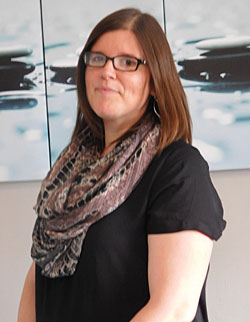 by Bonnie Williamson
by Bonnie Williamson
Different approaches to health care are becoming more and more popular. One of these approaches is massage therapy.
Yet massage therapy is nothing new. It has been practiced for thousands of years. There are more than 80 massage therapy styles that involve different pressures, movements and techniques. Muscles and other soft tissues are pressed, rubbed and manipulated. According to the American Massage Therapy Association (AMTA), up to 25 percent of American adults had a massage at least once during 2016-2017. And, they have a wide range of reasons for doing so. More and more people are recognizing the health benefits of massage to gain relief or heal injuries, to help with certain health conditions and to promote overall wellness. Massage is also a great way to relieve stress.
The world is a stressful place. Trying to keep it together while problems continue to crop up day after day can be exhausting. Not only that, people can be doing tremendous harm to their bodies without even realizing it. Spending so much time meeting the needs of others, ignoring one’s own needs, can take its toll. Ignorance is not bliss.
The motto of a new business, “Self-care is not selfish,” is taken seriously by Angela Wethington, a licensed massage therapist (LMT), who recently expanded her business, Synergy Massage and Wellness, in July of last year. Synergy, located in Martinsburg, West Virginia, is not a spa, but features a holistic approach to health. Synergy offers a variety of bodywork modalities, stretching, massage related to self-care tips, as well as Tai Chi and Yin Yoga with Fascia Release. Synergy also plans to host nutritional workshops provided by certified professionals throughout the year.
Those at Synergy strive to keep the body balanced, When balanced, it functions better as a whole unit. When an imbalance exists in one area, pain and stiffness can often be felt elsewhere.
“For example, you may have a pain in your neck that could actually be caused by a problem with your foot as the body is continually trying to correct itself on the next level in the body’s kinetic chain. We’ve had clients hobble in and walk out feeling better. It is so rewarding. We work with the nervous system through receptors in the body to help facilitate the body’s natural healing response. Sometimes it almost seems like magic how the body responds to certain techniques. Clients have remarked after a session that they had forgotten how good they could feel.” Wethington says, smiling.
Working with the nervous system explains the business’ name: Synergy. Synergy is defined as the interaction or cooperation of two or more organizations, substances, or other agents to produce a combined effect greater than the sum of their separate effects. Synergy makes a better whole.
While Synergy addresses the needs of anyone in need of massage therapy, Wethington says, “Pain knows no age, but the majority of our clients are middle-aged women. Women tend to hold things in. They put themselves on the back burner. Many clients come to us after years of dealing with a chronic issue and say they didn’t know massage was something that could help them. They thought massage was just something they treated themselves to for their birthday once a year. Our goal is to let them know that massage therapy is not just a luxury. Massage is effective at relieving pain as well as stress.”
Wethington continues, “You can almost tell where someone will have aches and pains by what they do for a living. Teachers have a stressful job and often receive massage therapy for tension headaches. Tension often manifests in the neck and shoulders. Those with jobs that require twisting, bending, and lifting complain of low back pain. Truck drivers may have problems caused by the constant shifting of gears.”
Even golfers are at risk for muscular skeletal issues.
“It’s the constant repetitive movement on one side that can cause an imbalance and subsequent muscle compensation patterns,” Wethington says.
Massage is often associated with stress reduction and relaxation. However, massage therapists can also use specific soft tissue techniques to relieve pain stemming from a multitude of conditions, such as sciatica and frozen shoulder. In this type of clinical session, the practitioner works with the client who is fully clothed on a table, much like a sports massage would be given during an athletic event.
Synergy also currently offers Swedish, deep tissue, craniosacral therapy, lymphatic, and hot stone massages.
“A traditional bodywork session not only stimulates circulation and improves lymphatic flow, but also soothes the nervous system to relieve stress. Who doesn’t need that?” Wethington says.
Synergy also offers additional massage modalities, including neuromuscular therapy; trigger point therapy (trigger points are spots in the skeletal muscle that produce pain when compressed); craniosacral therapy where a gentle touch palpates portions of the head and light touches are made to the spine and pelvic bones; myofascial massage that treats immobility and pain by massaging and stretching muscles and connective tissue called fascia; foot reflexology sessions; and even something called cupping therapy where silicone cups are placed on the skin, creating a local suction that stimulates circulation and fascia release.
“Many of our clients with fibromyalgia have reported overwhelming relief from cupping and fascia release techniques. Fascia is a web of connective tissue in our body. Our muscles, nerves, and vessels are intertwined throughout our fascia. When fascia is tight, it pulls on these structures, which can cause pain and irritation. Fascia release can relieve pain associated with tight fascia,” Wethington says.
The benefits of the different massage therapies are wide ranging. The AMTA lists 25 conditions helped by massage, which include stress relief, of course; relieving postoperative pain; helping with anxiety; management of low back pain; helping with fibromyalgia, a disorder characterized by widespread musculoskeletal pain accompanied by fatigue, sleep, memory and mood issues; the reduction of muscle tension; enhance exercise performance; relieve tension headaches; help patients sleep better; ease symptoms of depression; improve cardiovascular health; reduce pain from osteoarthritis; decrease stress in cancer patients; improve balance in older adults; decrease pain from rheumatoid arthritis; temper effects of dementia; lower blood pressure; reduce symptoms of Carpal Tunnel Syndrome; help chronic neck pain; lower joint replacement pain; increase range of motion; decrease frequency of migraine headaches; improve quality of life for hospice care patients; and reduce nausea related to chemotherapy. Massages can also improve concentration and productivity.
Wethington adds that massage therapy can also help with the current opioid crisis hitting America.
“We offer a natural alternative to managing pain,” she says. “I think the type of bodywork we provide is definitely becoming more mainstream. Therapeutic massage focuses on relieving aches and pains, as well as providing stress relief.”
Having a one to one relationships with clients is very important, Wethington says.
“Our practitioners take an individualized approach,” she continues. “We talk to our clients. We listen to them. We are offering additional bodywork modalities that, until now, haven’t been readily available in our area. Previously, one would need to drive to the city to receive bodywork such as Ashiatsu, Thai for the table, and traditional mat-based Thai massage. We saw a need for that here in Berkeley County. Our practitioners are committed to constantly expanding their knowledge base in order to provide our clients with the highest quality treatments possible.”
Bodywork sessions can last from 30 minutes to 120 minutes.
The Synergy approach has been successful so far. The practice has grown to more than 250 clients in just over a year and is expanding rapidly. In addition to Wethington, Synergy’s team includes Curran Johnston (LMT), Jilly Simerly (LMT), Stephanie Goddard (LMT), and John Amorelli (LMT and Tai Chi instructor) and JoAnn Brennan (Yoga instructor) who offers unique Yin Yoga with Fascia Release classes at Synergy.
Wethington’s experience includes working as an assistant in a chiropractic office. She went on to obtain her West Virginia Massage Therapy License after completing the massage therapy program at James Rumsey Technical Institute in 2014.
For more information on Synergy Massage and Wellness, go to the website at www.synergymassageandwellness.net, check out Facebook or call 304-582-5937.

